外研版(2019)选择性必修第三册 Unit5Learning from nature Using language 公开课课件(共48张PPT)
文档属性
| 名称 | 外研版(2019)选择性必修第三册 Unit5Learning from nature Using language 公开课课件(共48张PPT) | 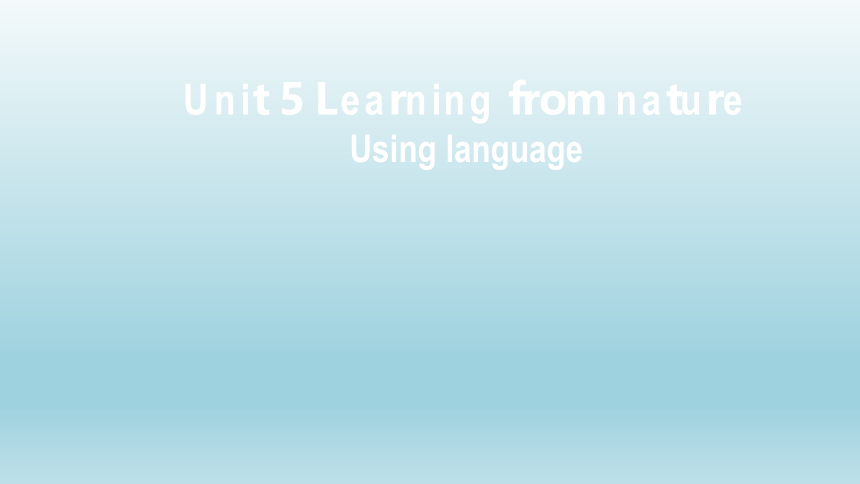 | |
| 格式 | pptx | ||
| 文件大小 | 4.3MB | ||
| 资源类型 | 教案 | ||
| 版本资源 | 外研版(2019) | ||
| 科目 | 英语 | ||
| 更新时间 | 2023-03-06 21:03:02 | ||
图片预览

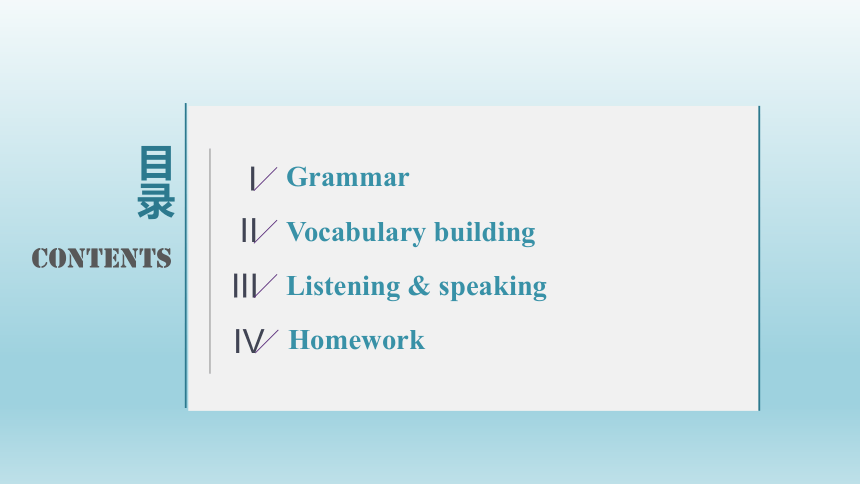
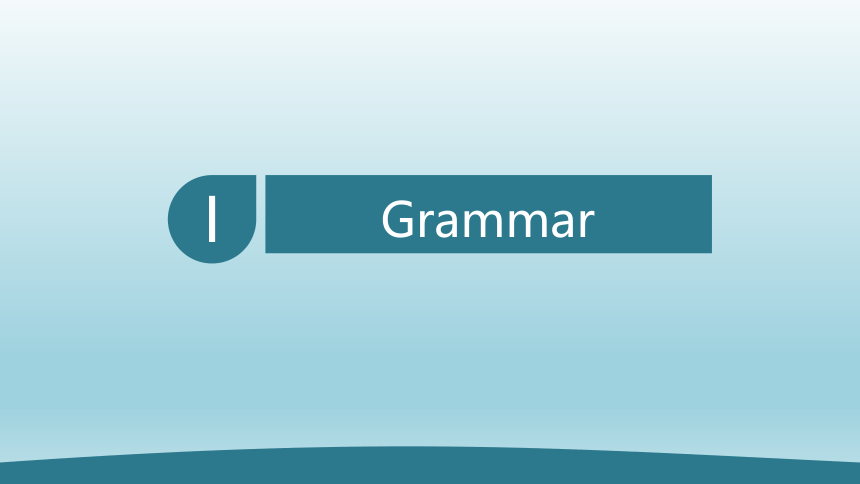
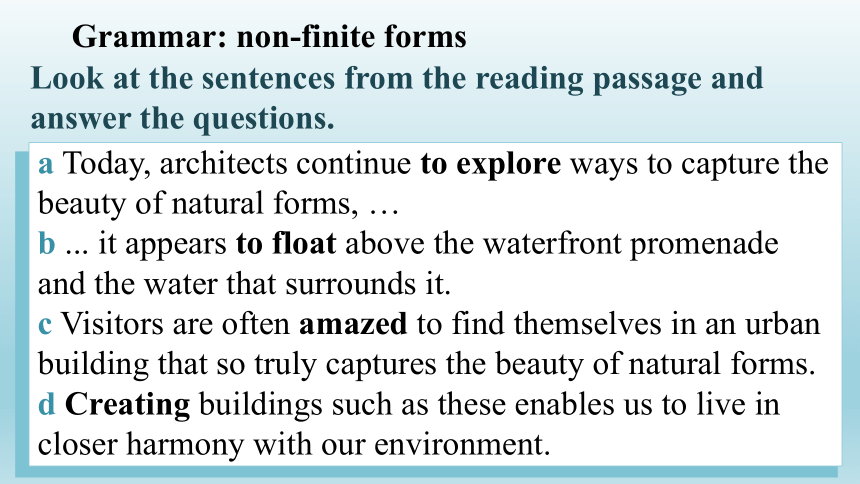

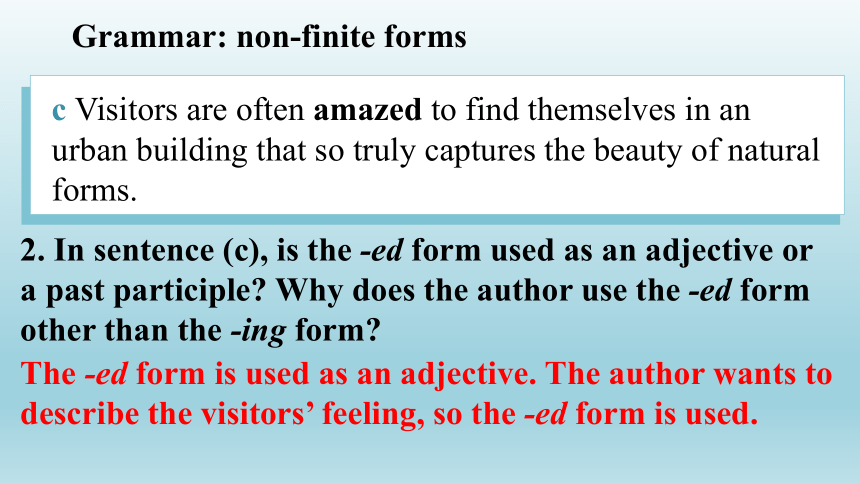
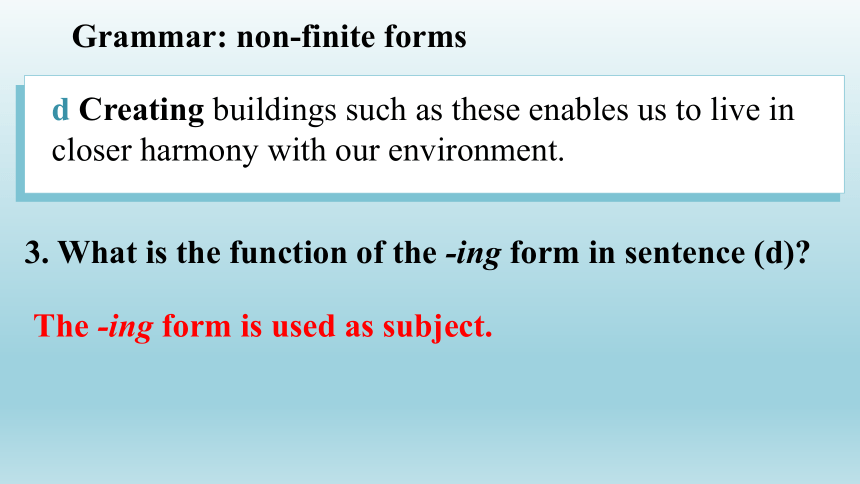
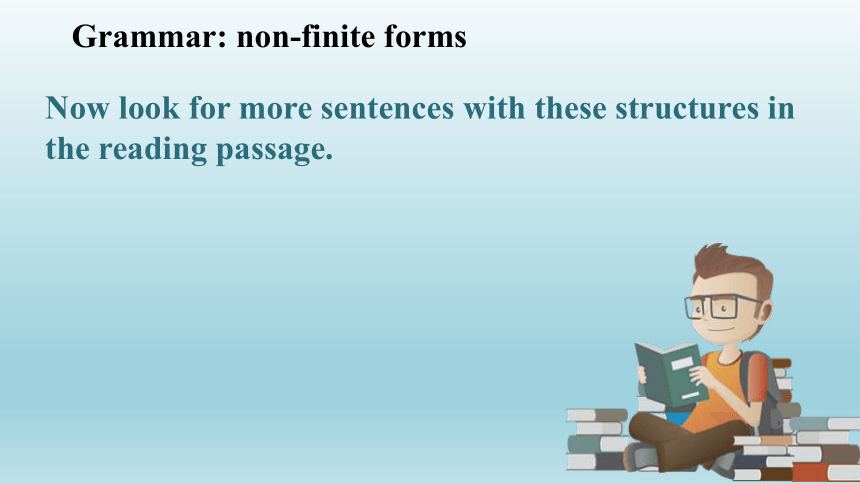
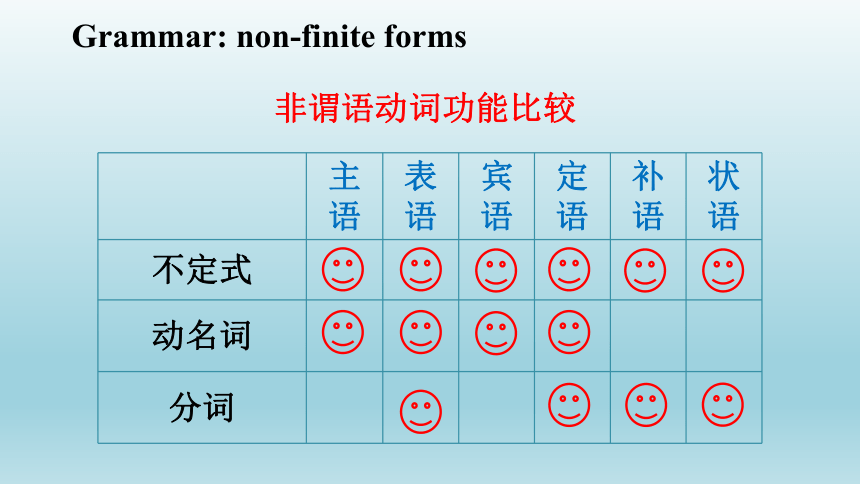
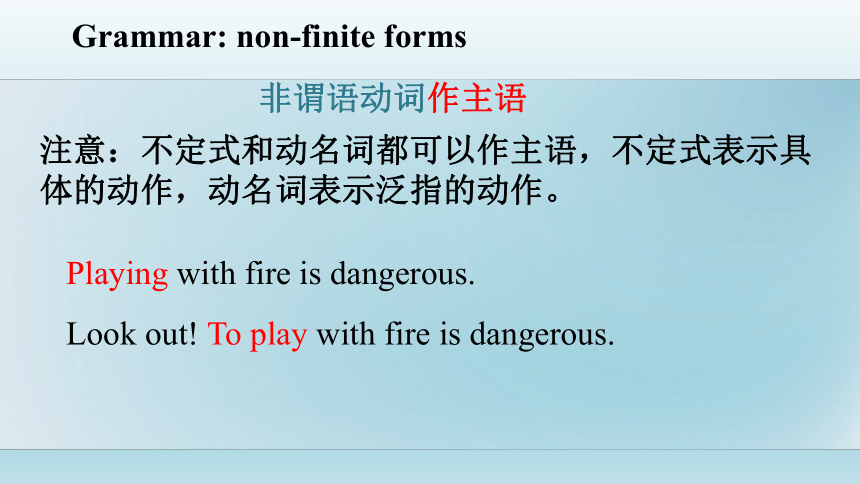
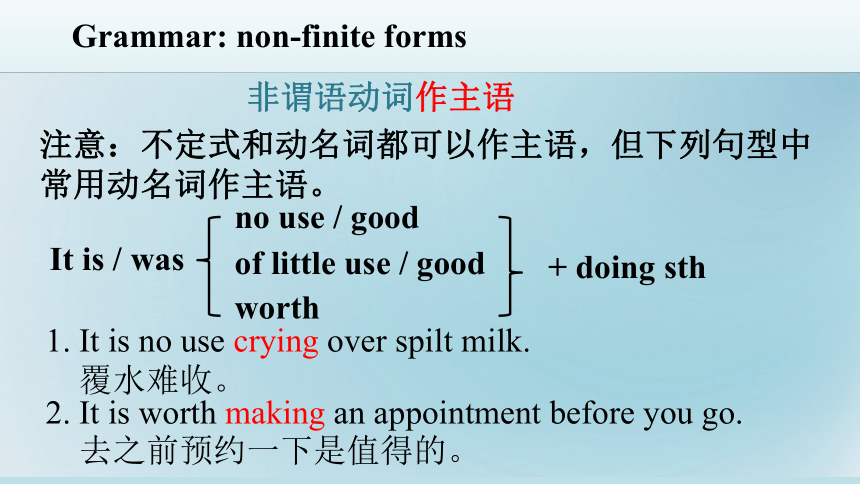
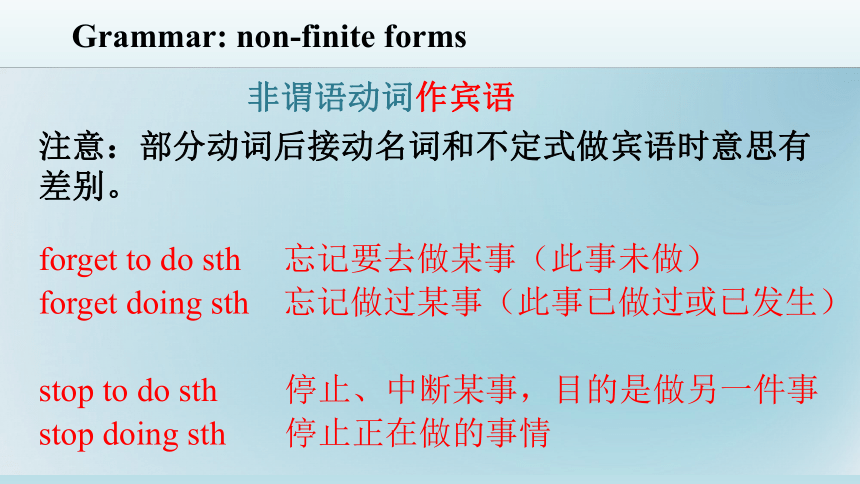
文档简介
(共48张PPT)
Using language
Unit 5 Learning from nature
目录
contents
Grammar
I
IV
Vocabulary building
II
Listening & speaking
III
Homework
I
Grammar
Look at the sentences from the reading passage and answer the questions.
a Today, architects continue to explore ways to capture the beauty of natural forms, …
b ... it appears to float above the waterfront promenade
and the water that surrounds it.
c Visitors are often amazed to find themselves in an urban building that so truly captures the beauty of natural forms.
d Creating buildings such as these enables us to live in
closer harmony with our environment.
Grammar: non-finite forms
0,000 people reading my blog! b I love to photograph the rising sun, …
a Today, architects continue to explore ways to capture the beauty of natural forms, …
b ... it appears to float above the waterfront promenade
and the water that surrounds it.
1. Look at the “to do” structures in sentences (a) and (b). Do they serve the same function in each sentence
No, they don’t. “To explore” in sentence (a) serves as object and “to float” in sentence (b) serves as predicative.
Grammar: non-finite forms
0,000 people reading my blog! b I love to photograph the rising sun, …
c Visitors are often amazed to find themselves in an urban building that so truly captures the beauty of natural forms.
2. In sentence (c), is the -ed form used as an adjective or a past participle Why does the author use the -ed form
other than the -ing form
The -ed form is used as an adjective. The author wants to describe the visitors’ feeling, so the -ed form is used.
Grammar: non-finite forms
0,000 people reading my blog! b I love to photograph the rising sun, …
d Creating buildings such as these enables us to live in
closer harmony with our environment.
3. What is the function of the -ing form in sentence (d)
The -ing form is used as subject.
Grammar: non-finite forms
Now look for more sentences with these structures in the reading passage.
Grammar: non-finite forms
主语 表语 宾语 定语 补语 状语
不定式
动名词
分词
非谓语动词功能比较
Grammar: non-finite forms
注意:不定式和动名词都可以作主语,不定式表示具体的动作,动名词表示泛指的动作。
Playing with fire is dangerous.
Look out! To play with fire is dangerous.
非谓语动词作主语
Grammar: non-finite forms
注意:不定式和动名词都可以作主语,但下列句型中常用动名词作主语。
1. It is no use crying over spilt milk.
覆水难收。
2. It is worth making an appointment before you go.
去之前预约一下是值得的。
非谓语动词作主语
It is / was
no use / good
worth
of little use / good
Grammar: non-finite forms
+ doing sth
非谓语动词作宾语
注意:部分动词后接动名词和不定式做宾语时意思有差别。
Grammar: non-finite forms
forget to do sth 忘记要去做某事(此事未做)
forget doing sth 忘记做过某事(此事已做过或已发生)
stop to do sth 停止、中断某事,目的是做另一件事
stop doing sth 停止正在做的事情
非谓语动词作宾语
注意:部分动词后接动名词和不定式作宾语时意思有差别。
Grammar: non-finite forms
remember to do sth 记住去做某事
remember doing sth 记得做过某事
regret to do sth 对要做的事表示遗憾
regret doing sth 对做过的事感到后悔
非谓语动词作宾语
try to do sth 努力做某事
try doing sth 尝试着做某事
mean to do sth 打算 / 有意要做某事
mean doing sth 意味着做某事
go on to do sth 继而(去做另外一件事)
go on doing sth 继续(原先没有做完的事)
Grammar: non-finite forms
非谓语动词作宾语
dread doing sth 害怕担心做某事
dread to do sth 不敢去做某事(表示对某事十分担忧)
can’t help doing sth 情不自禁做某事
can’t help (to) do sth 不能帮忙做某事
Grammar: non-finite forms
注意:若主语和表语都是非谓语动词,应保持形式上一致。
Seeing is believing.
= To see is to believe.
眼见为实。
非谓语动词作表语
Grammar: non-finite forms
Complete the passage with the correct form of the verbs in brackets.
1. ________ (draw) inspiration from nature is a tradition that goes back centuries. Nowhere is this better illustrated than in the beautiful Lingering Garden of Suzhou. The main principle of its design is 2. ___________________ (recreate) natural landscapes in miniature. First established in the Ming Dynasty, the original garden contained a rockery to symbolise Tiantai Mountain. Pine and bamboo
Drawing
to recreate / recreating
Grammar: non-finite forms
groves were added later, along with a pond and an island. Visitors would be 3. _________ (astonish) to find the garden modeled closely on natural features.Visitors are also supposed 4. __________ (explore) it scene-by-scene. This could vary from a view of a pond and the splashing of fish, to a tree in blossom, a pagoda or a moon-shaped gate.
astonished
to explore
Grammar: non-finite forms
Complete the passage with the correct form of the verbs in brackets.
Read the information below and write a paragraph introducing the 24 Solar Terms with the words in the
box. Use the structures you have learnt in this unit
where appropriate.
learn determine show
amaze use
Grammar: non-finite forms
Origin
created by farmers in Ancient China
based on Chinese lunar calendar
determined by the changes in the position of the sun
Significance
changes in weather mean a lot to farmers
determine the best time to sow and harvest
wisdom learnt from nature
Grammar: non-finite forms
First term
Beginning of Spring
days become longer and the temperature increases
Cultural heritage
added to UNESCO’s List of Intangible Cultural Heritage in 2016
Grammar: non-finite forms
立春 the Beginning of Spring
雨水 Rain Water
惊蛰 the Waking of Insects
春分 the Spring Equinox
清明 Pure Brightness
谷雨 Grain Rain
the 24 Solar Terms
Grammar: non-finite forms
立夏 the Beginning of Summer
小满 Lesser Fullness of Grain
芒种 Grain in Beard
夏至 the Summer Solstice
小暑 Lesser Heat
大暑 Greater Heat
立冬 the Beginning of Winter
小雪 Lesser Snow
大雪 Greater Snow
冬至 the Winter Solstice
小寒 Lesser Cold
大寒 Greater Cold
the 24 Solar Terms
Grammar: non-finite forms
立秋 the Beginning of Autumn
处暑 the End of Heat
白露 White Dew
秋分 the Autumn Equinox
寒露 Cold Dew
霜降 Frost’s Descent
Learning from nature’s wisdom led farmers in Ancient China to create the 24 Solar Terms, which were based on observation of changes of seasons, astronomy and other natural phenomena. Indicating changes in weather conditions, the 24 Solar Terms remain of particular importance to farmers for guiding their practices. The first term is known as “Beginning of
Example
Grammar: non-finite forms
Spring”, and marks when days become longer and the temperature begins to increase. Nowadays, the 24 Solar Terms not only apply to farming, but also guide Chinese people in everyday life. So varied are the functions of the Solar Terms and their contributions to cultural identity, that in 2016, they were added to UNESCO’s List of Intangible Cultural Heritage.
Example
Grammar: non-finite forms
Work in pairs. Talk about one of the Solar Terms using the structures you have learnt in this unit where appropriate.
cooperation
Grammar: non-finite forms
II
Vocabulary building
Vocabulary building: Inspiration from animals
Background Information
Biomimicry
Did you know
Biomimicry, also called bionics, is a branch of study which focuses on using nature as an inspiration to solve problems faced by the humans on Earth. People have been practicing biomimicry for centuries, but it has become a topic of special interest in the modern world in the hope that it could be a driving force behind more sustainable design.
Vocabulary building: Inspiration from animals
Read the passage about biomimicry and answer the questions. Pay attention to the words and expressions in bold.
1. observe __________________
2. imitate __________________
3. seek solutions to ... __________________
4. copy __________________
5. take inspiration from ... __________________
6. (be) inspired by ... __________________
观察;观测
模仿;仿效
寻求……的解决方法
从……获得灵感
受……的启发 / 启迪
Vocabulary building: Inspiration from animals
复制;抄写
Vocabulary building: Inspiration from animals
1. What are the types of biomimicry mentioned in the passage What else do you know about them
One is copying form and shape. Another one is taking inspiration from the abilities of animals.
Read the passage about biomimicry and answer the qusetions.
2. What other examples of biomimicry can you think of Share them with the class.
Students’ own answers.
Vocabulary building: Inspiration from animals
Bats use sound to “see”. But how do they avoid crashing into each other The answer lies in their use of echo-location to identify the position of objects. Scientists are 1. ____________________ bats to improve radar systems.
taking inspiration from
Complete the information with the words and expressions
in Activity 5.
Vocabulary building: Inspiration from animals
As a land species, how can we improve our performance in water 2. _________
the shape of the scales on a shark’s skin, we have created swimsuits that allow
swimmers to swim much faster.
Copying
Complete the information with the words and expressions
in Activity 5.
Complete the information with the words and expressions
in Activity 5.
Vocabulary building: Inspiration from animals
By 3. __________ dragonflies in flight, people have realised there are better ways of flying. Now we are 4. ___________
dragonflies with our designs for small drones.
observing
inspired by
Vocabulary building: Inspiration from animals
Spider silk is much stronger than the same weight of steel. This means that it could be used in lots of products, such as bullet-proof clothing. But we are still 5. __________________ one problem — how to get spiders to produce enough silk!
seeking solutions to
Complete the information with the words and expressions
in Activity 5.
Vocabulary building: Inspiration from animals
Now work in pairs. Talk about in what other ways we can learn from animals. Give examples.
III
Listening & speaking
Listening & speaking: Before listening
1. Why were Chinese martial artists inspired by animals movements
Read the passage and answer the questions.
Because many Chinese martial artists admired the natural instincts, senses and fighting abilities that animals possess in order to survive in the wild.
Listening & speaking: Before listening
2. What were Hua Tuo’s achievements
Read the passage and answer the questions.
Hua Tuo created Wu Qin Xi. He was the first physician to use anesthesia during surgery in China. He was known as the best physician of his time and he was an expert in acupuncture.
The creator of Wu Qin Xi
Who can practise the exercises
Why these animals were chosen
Physical benefits
Mental benefits
How to teach the exercises
Listening & speaking: While-listening
Listen to the conversation about Wu Qin Xi and tick the topics mentioned by the speakers.
√
√
√
Listening & speaking: While-listening
Listen again and complete the introduction to Wu Qin Xi.
Wu Qin Xi was created by Hua Tuo almost 2,000 years ago. It means “Five-animal Exercises”, and each animal is 1. ___________________________. By doing these exercises, people learn from these animals and help 2. _____________
____________. For example, the tiger exercise 3. _________ the liver. The bear exercise helps people with good digestion. The monkey exercise helps 4. __________________; the 5. ___________ is good for the kidney; and the crane exercise
identified with a form of exercise
the / their organs
to work better
does good to
the heart to work well
deer exercise
Listening & speaking: While-listening
Listen again and complete the introduction to Wu Qin Xi.
is 6. _______________. Some people believe Wu Qin Xi helps them 7. _____________________. Some of the Wu Qin Xi masters lived to 8. _______________________, and still had good eyesight, hearing and strong teeth. Wu Qin Xi has 9. _____________, too. It can help 10. ______________
______________________.
good for the lung
to live to an advanced age
more than 90 years of age
mental benefits
to relax the mind
and improve concentration
Listening & speaking: Summary
Complete the boxes with the expressions from the conversation.
have fun
By …, you learn ... That’s interesting!
Really That’s very impressive.
It helps people to ... Sounds great!
... is good for ...
Talking about benefits Showing interest
Listening & speaking: Summary
Complete the boxes with the expressions from the conversation.
have fun
Talking about benefits Showing interest
By ..., you learn ...
It helps people to ...
... is good for ...
Really
That’s interesting!
That’s very impressive. Sounds great!
Listening & speaking: Pair work
Work in pairs. Think about other exercises inspired by animals. Discuss how they were created and their benefits, using the words and expressions in this section.
Now think about your performance. How well can you use the language you have learnt to talk about traditional Chinese exercises
Listening & speaking
IV
Homework
Homework
1. Review non-finite forms as subject,
object and predicative.
2. Write a short passage about something
learned from nature’s wisdom.
Using language
Unit 5 Learning from nature
目录
contents
Grammar
I
IV
Vocabulary building
II
Listening & speaking
III
Homework
I
Grammar
Look at the sentences from the reading passage and answer the questions.
a Today, architects continue to explore ways to capture the beauty of natural forms, …
b ... it appears to float above the waterfront promenade
and the water that surrounds it.
c Visitors are often amazed to find themselves in an urban building that so truly captures the beauty of natural forms.
d Creating buildings such as these enables us to live in
closer harmony with our environment.
Grammar: non-finite forms
0,000 people reading my blog! b I love to photograph the rising sun, …
a Today, architects continue to explore ways to capture the beauty of natural forms, …
b ... it appears to float above the waterfront promenade
and the water that surrounds it.
1. Look at the “to do” structures in sentences (a) and (b). Do they serve the same function in each sentence
No, they don’t. “To explore” in sentence (a) serves as object and “to float” in sentence (b) serves as predicative.
Grammar: non-finite forms
0,000 people reading my blog! b I love to photograph the rising sun, …
c Visitors are often amazed to find themselves in an urban building that so truly captures the beauty of natural forms.
2. In sentence (c), is the -ed form used as an adjective or a past participle Why does the author use the -ed form
other than the -ing form
The -ed form is used as an adjective. The author wants to describe the visitors’ feeling, so the -ed form is used.
Grammar: non-finite forms
0,000 people reading my blog! b I love to photograph the rising sun, …
d Creating buildings such as these enables us to live in
closer harmony with our environment.
3. What is the function of the -ing form in sentence (d)
The -ing form is used as subject.
Grammar: non-finite forms
Now look for more sentences with these structures in the reading passage.
Grammar: non-finite forms
主语 表语 宾语 定语 补语 状语
不定式
动名词
分词
非谓语动词功能比较
Grammar: non-finite forms
注意:不定式和动名词都可以作主语,不定式表示具体的动作,动名词表示泛指的动作。
Playing with fire is dangerous.
Look out! To play with fire is dangerous.
非谓语动词作主语
Grammar: non-finite forms
注意:不定式和动名词都可以作主语,但下列句型中常用动名词作主语。
1. It is no use crying over spilt milk.
覆水难收。
2. It is worth making an appointment before you go.
去之前预约一下是值得的。
非谓语动词作主语
It is / was
no use / good
worth
of little use / good
Grammar: non-finite forms
+ doing sth
非谓语动词作宾语
注意:部分动词后接动名词和不定式做宾语时意思有差别。
Grammar: non-finite forms
forget to do sth 忘记要去做某事(此事未做)
forget doing sth 忘记做过某事(此事已做过或已发生)
stop to do sth 停止、中断某事,目的是做另一件事
stop doing sth 停止正在做的事情
非谓语动词作宾语
注意:部分动词后接动名词和不定式作宾语时意思有差别。
Grammar: non-finite forms
remember to do sth 记住去做某事
remember doing sth 记得做过某事
regret to do sth 对要做的事表示遗憾
regret doing sth 对做过的事感到后悔
非谓语动词作宾语
try to do sth 努力做某事
try doing sth 尝试着做某事
mean to do sth 打算 / 有意要做某事
mean doing sth 意味着做某事
go on to do sth 继而(去做另外一件事)
go on doing sth 继续(原先没有做完的事)
Grammar: non-finite forms
非谓语动词作宾语
dread doing sth 害怕担心做某事
dread to do sth 不敢去做某事(表示对某事十分担忧)
can’t help doing sth 情不自禁做某事
can’t help (to) do sth 不能帮忙做某事
Grammar: non-finite forms
注意:若主语和表语都是非谓语动词,应保持形式上一致。
Seeing is believing.
= To see is to believe.
眼见为实。
非谓语动词作表语
Grammar: non-finite forms
Complete the passage with the correct form of the verbs in brackets.
1. ________ (draw) inspiration from nature is a tradition that goes back centuries. Nowhere is this better illustrated than in the beautiful Lingering Garden of Suzhou. The main principle of its design is 2. ___________________ (recreate) natural landscapes in miniature. First established in the Ming Dynasty, the original garden contained a rockery to symbolise Tiantai Mountain. Pine and bamboo
Drawing
to recreate / recreating
Grammar: non-finite forms
groves were added later, along with a pond and an island. Visitors would be 3. _________ (astonish) to find the garden modeled closely on natural features.Visitors are also supposed 4. __________ (explore) it scene-by-scene. This could vary from a view of a pond and the splashing of fish, to a tree in blossom, a pagoda or a moon-shaped gate.
astonished
to explore
Grammar: non-finite forms
Complete the passage with the correct form of the verbs in brackets.
Read the information below and write a paragraph introducing the 24 Solar Terms with the words in the
box. Use the structures you have learnt in this unit
where appropriate.
learn determine show
amaze use
Grammar: non-finite forms
Origin
created by farmers in Ancient China
based on Chinese lunar calendar
determined by the changes in the position of the sun
Significance
changes in weather mean a lot to farmers
determine the best time to sow and harvest
wisdom learnt from nature
Grammar: non-finite forms
First term
Beginning of Spring
days become longer and the temperature increases
Cultural heritage
added to UNESCO’s List of Intangible Cultural Heritage in 2016
Grammar: non-finite forms
立春 the Beginning of Spring
雨水 Rain Water
惊蛰 the Waking of Insects
春分 the Spring Equinox
清明 Pure Brightness
谷雨 Grain Rain
the 24 Solar Terms
Grammar: non-finite forms
立夏 the Beginning of Summer
小满 Lesser Fullness of Grain
芒种 Grain in Beard
夏至 the Summer Solstice
小暑 Lesser Heat
大暑 Greater Heat
立冬 the Beginning of Winter
小雪 Lesser Snow
大雪 Greater Snow
冬至 the Winter Solstice
小寒 Lesser Cold
大寒 Greater Cold
the 24 Solar Terms
Grammar: non-finite forms
立秋 the Beginning of Autumn
处暑 the End of Heat
白露 White Dew
秋分 the Autumn Equinox
寒露 Cold Dew
霜降 Frost’s Descent
Learning from nature’s wisdom led farmers in Ancient China to create the 24 Solar Terms, which were based on observation of changes of seasons, astronomy and other natural phenomena. Indicating changes in weather conditions, the 24 Solar Terms remain of particular importance to farmers for guiding their practices. The first term is known as “Beginning of
Example
Grammar: non-finite forms
Spring”, and marks when days become longer and the temperature begins to increase. Nowadays, the 24 Solar Terms not only apply to farming, but also guide Chinese people in everyday life. So varied are the functions of the Solar Terms and their contributions to cultural identity, that in 2016, they were added to UNESCO’s List of Intangible Cultural Heritage.
Example
Grammar: non-finite forms
Work in pairs. Talk about one of the Solar Terms using the structures you have learnt in this unit where appropriate.
cooperation
Grammar: non-finite forms
II
Vocabulary building
Vocabulary building: Inspiration from animals
Background Information
Biomimicry
Did you know
Biomimicry, also called bionics, is a branch of study which focuses on using nature as an inspiration to solve problems faced by the humans on Earth. People have been practicing biomimicry for centuries, but it has become a topic of special interest in the modern world in the hope that it could be a driving force behind more sustainable design.
Vocabulary building: Inspiration from animals
Read the passage about biomimicry and answer the questions. Pay attention to the words and expressions in bold.
1. observe __________________
2. imitate __________________
3. seek solutions to ... __________________
4. copy __________________
5. take inspiration from ... __________________
6. (be) inspired by ... __________________
观察;观测
模仿;仿效
寻求……的解决方法
从……获得灵感
受……的启发 / 启迪
Vocabulary building: Inspiration from animals
复制;抄写
Vocabulary building: Inspiration from animals
1. What are the types of biomimicry mentioned in the passage What else do you know about them
One is copying form and shape. Another one is taking inspiration from the abilities of animals.
Read the passage about biomimicry and answer the qusetions.
2. What other examples of biomimicry can you think of Share them with the class.
Students’ own answers.
Vocabulary building: Inspiration from animals
Bats use sound to “see”. But how do they avoid crashing into each other The answer lies in their use of echo-location to identify the position of objects. Scientists are 1. ____________________ bats to improve radar systems.
taking inspiration from
Complete the information with the words and expressions
in Activity 5.
Vocabulary building: Inspiration from animals
As a land species, how can we improve our performance in water 2. _________
the shape of the scales on a shark’s skin, we have created swimsuits that allow
swimmers to swim much faster.
Copying
Complete the information with the words and expressions
in Activity 5.
Complete the information with the words and expressions
in Activity 5.
Vocabulary building: Inspiration from animals
By 3. __________ dragonflies in flight, people have realised there are better ways of flying. Now we are 4. ___________
dragonflies with our designs for small drones.
observing
inspired by
Vocabulary building: Inspiration from animals
Spider silk is much stronger than the same weight of steel. This means that it could be used in lots of products, such as bullet-proof clothing. But we are still 5. __________________ one problem — how to get spiders to produce enough silk!
seeking solutions to
Complete the information with the words and expressions
in Activity 5.
Vocabulary building: Inspiration from animals
Now work in pairs. Talk about in what other ways we can learn from animals. Give examples.
III
Listening & speaking
Listening & speaking: Before listening
1. Why were Chinese martial artists inspired by animals movements
Read the passage and answer the questions.
Because many Chinese martial artists admired the natural instincts, senses and fighting abilities that animals possess in order to survive in the wild.
Listening & speaking: Before listening
2. What were Hua Tuo’s achievements
Read the passage and answer the questions.
Hua Tuo created Wu Qin Xi. He was the first physician to use anesthesia during surgery in China. He was known as the best physician of his time and he was an expert in acupuncture.
The creator of Wu Qin Xi
Who can practise the exercises
Why these animals were chosen
Physical benefits
Mental benefits
How to teach the exercises
Listening & speaking: While-listening
Listen to the conversation about Wu Qin Xi and tick the topics mentioned by the speakers.
√
√
√
Listening & speaking: While-listening
Listen again and complete the introduction to Wu Qin Xi.
Wu Qin Xi was created by Hua Tuo almost 2,000 years ago. It means “Five-animal Exercises”, and each animal is 1. ___________________________. By doing these exercises, people learn from these animals and help 2. _____________
____________. For example, the tiger exercise 3. _________ the liver. The bear exercise helps people with good digestion. The monkey exercise helps 4. __________________; the 5. ___________ is good for the kidney; and the crane exercise
identified with a form of exercise
the / their organs
to work better
does good to
the heart to work well
deer exercise
Listening & speaking: While-listening
Listen again and complete the introduction to Wu Qin Xi.
is 6. _______________. Some people believe Wu Qin Xi helps them 7. _____________________. Some of the Wu Qin Xi masters lived to 8. _______________________, and still had good eyesight, hearing and strong teeth. Wu Qin Xi has 9. _____________, too. It can help 10. ______________
______________________.
good for the lung
to live to an advanced age
more than 90 years of age
mental benefits
to relax the mind
and improve concentration
Listening & speaking: Summary
Complete the boxes with the expressions from the conversation.
have fun
By …, you learn ... That’s interesting!
Really That’s very impressive.
It helps people to ... Sounds great!
... is good for ...
Talking about benefits Showing interest
Listening & speaking: Summary
Complete the boxes with the expressions from the conversation.
have fun
Talking about benefits Showing interest
By ..., you learn ...
It helps people to ...
... is good for ...
Really
That’s interesting!
That’s very impressive. Sounds great!
Listening & speaking: Pair work
Work in pairs. Think about other exercises inspired by animals. Discuss how they were created and their benefits, using the words and expressions in this section.
Now think about your performance. How well can you use the language you have learnt to talk about traditional Chinese exercises
Listening & speaking
IV
Homework
Homework
1. Review non-finite forms as subject,
object and predicative.
2. Write a short passage about something
learned from nature’s wisdom.
